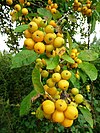
Philipp Franz Balthasar von Siebold was a German physician, botanist and traveller. He achieved prominence by his studies of Japanese flora and fauna and the introduction of Western medicine in Japan. He was the father of the first female Japanese doctor educated in Western medicine, Kusumoto Ine.

Malus is a genus of about 32–57 species of small deciduous trees or shrubs in the family Rosaceae, including the domesticated orchard apple, crab apples and wild apples.

Magnolia sieboldii, or Siebold's magnolia, also known as Korean mountain magnolia and Oyama magnolia, is a species of Magnolia native to east Asia in China, Japan, and Korea. It is named after the German doctor Philipp Franz von Siebold (1796–1866).

Prunus serrulata or Japanese cherry is a species of cherry tree that grows naturally in Japan, China, Korea, and Vietnam, and it also refers to a cultivar produced from Prunus speciosa, a cherry tree endemic in Japan. Historically, the Japanese have developed many cultivars by selective breeding of cherry trees, which are produced by the complicated crossing of several wild species, and they are used for ornamental purposes all over the world. Of these, the cultivars produced by complex interspecific hybrids based on the Oshima cherry are also known as the Cerasus Sato-zakura Group.
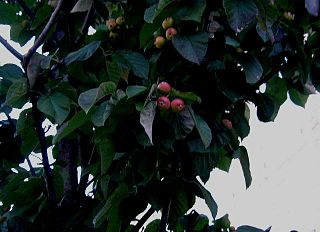
Macromeles tschonoskii is a species of flowering plant in the family Rosaceae. It is a tree endemic to Japan.

Malus floribunda, common name Japanese flowering crabapple, Japanese crab, purple chokeberry, or showy crabapple, originates from Japan and East Asia. It may be a hybrid of M. toringo with M. baccata, in which case it would be written as Malus × floribunda.
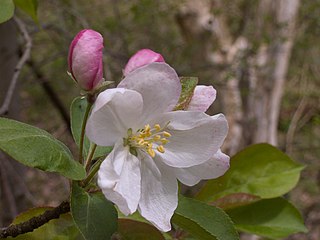
Malus coronaria, also known by the names sweet crabapple or garland crab, is a North American species of Malus (crabapple).
Pseudocercospora mali is a fungal plant pathogen infecting Apple trees. It was originally found on the living leaves of Pyrus malus in Louisiana, USA.
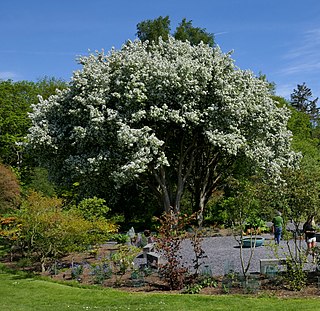
Malus hupehensis, common names Chinese crab apple, Hupeh crab or tea crabapple, is a species of flowering plant in the apple genus Malus of the family Rosaceae.

Malus fusca, with the common names Oregon crabapple and Pacific crabapple, is a species of crabapple native to western North America.

Malus angustifolia, or southern crabapple, is a species of crabapple native to the eastern and south-central United States.

Malus baccata is an Asian species of apple known by the common names Siberian crab apple, Siberian crab, Manchurian crab apple and Chinese crab apple. It is native to many parts of Asia, but is also grown elsewhere as an ornamental tree and for rootstock. It is used for bonsai. It bears plentiful, fragrant, white flowers and edible red to yellow fruit of about 1 cm diameter.
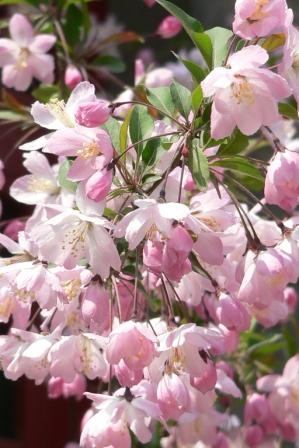
Malus halliana is an East Asian crabapple species of Malus, known by the common name Hall crabapple. Its Chinese name is chui si hai tang(垂丝海棠).

Malus ioensis, known as the Iowa crab or prairie crabapple, is a species of crabapple tree native to the United States. The most common variety, M. ioensis var. ioensis, is found primarily in the prairie regions of the upper Mississippi Valley. Another variety, M. ioensis var. texana, or the Texas crabapple, is found only in a small region of central Texas.
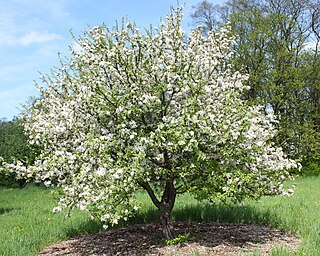
Malus prunifolia is a species of crabapple tree known by the common names plumleaf crab apple, plum-leaved apple, pear-leaf crabapple, Chinese apple and Chinese crabapple. It is native to China, and is grown elsewhere for use as an ornamental tree or as rootstock. It reaches from between 3 and 8 meters tall and bears white flowers and yellow or red fruit.

Malus sargentii, the Sargent crabapple or Sargent's apple, is a species of flowering plant in the genus Malus of the family Rosaceae. The species was formerly considered a variety of the species Malus sieboldii. It is a shrub or small tree growing to 6–10 ft (1.8–3.0 m) tall and 6–12 ft (1.8–3.7 m) broad.

Malus spectabilis is a species of crabapple known by the common names Asiatic apple, Chinese crab, HaiTang and Chinese flowering apple.

Malus transitoria, the cut-leaf crabapple, is a species of flowering plant in the crabapple genus Malus of the family Rosaceae, native to China.

Primula sieboldii, the Japanese primrose, is a species of primrose that is endemic to East Asia. The species goes by common names such as Siebold's primrose, cherry blossom primrose, Japanese woodland primroseSnowflake, Geisha girl, Madam butterfly and the Japanese primrose which also applies to the related species Primula japonica.

Malus × zumi is a naturally occurring hybrid species of crabapple in the family Rosaceae, native to Japan, and a garden escapee in the US state of Ohio. Its parents are Manchurian crab apple Malus mandshurica and Siebold's crabapple Malus sieboldii. It is used as a salt‑tolerant rootstock for apples, Malus domestica, as it can survive NaCl concentrations up to 0.6%. A number of ornamental cultivars are available, including 'Golden Hornet' and 'Professor Sprenger'.




















